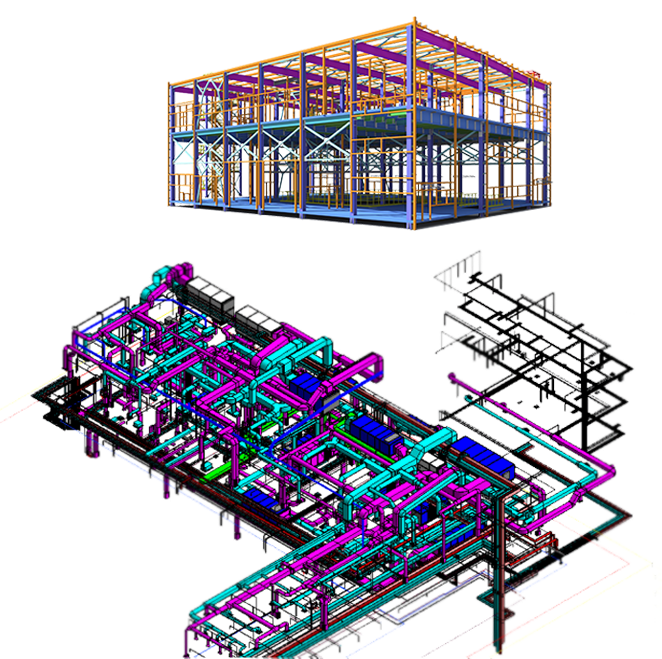Delve Into Silicon Valley’s Quality-assured MEP Coordination Services
Silicon Valley is a global preeminent MEP Coordination Services Provider that develops high-resolution 3D models and drawings for mechanical, electrical, and plumbing systems and integrates them with other building components, such as architectural, structural, facade, etc., to form a unified model. Our team provides Mechanical Coordination Services, Electrical Coordination Services, and Plumbing Coordination Services to meet the unique needs of high-rise buildings, manufacturing plants, shopping malls, resorts, hotels, theme parks, etc.
We are active with MEP BIM Coordination Services in USA, UK, UAE, Canada, Australia, Africa, and 100+ other countries. We specialize in Revit MEP Coordination Services. We employ Revit’s premier features like parametric modeling, integrating multiple models into one, energy analysis and load calculation, fabrication modeling, and numerous others, to validate error-free part production and placement. Our 3D MEP Coordination Services also stress sustainability and develop 3D plans for long-functioning MEP systems without breakage.
Our Multifaceted MEP Coordination Services
MEP BIM Coordination Services
BIM software helps merge MEP systems with architectural and structural frameworks cohesively. We offer MEP BIM Coordination Services and 3D MEP Coordination Services to resolve conflicts, optimize system performance, and provide accurate data for on-site operations.
MEP Coordination Drawings Services
MEP Technical drawings define the exact locations where MEP systems interact and overlap with the HVAC network. Our MEP Coordination Drawings Services and MEP Coordinated Shop Drawings Services coordinate ductwork, piping, and cable tray systems for better fabrication clarity.
MEP Coordination Design Services
Before jumping into advanced modeling and detailing, developing concepts and a foundation outline of the MEP framework is critical. We offer MEP Coordination Design Services that account for spatial requirements, system performance, and building codes based on project requirements.
Revit MEP Coordination Services
Silicon Valley’s Revit specialist provides accurate manufacturing data. Our Revit MEP Coordination Services and Revit MEP BIM Coordination Services help resolve geometric inaccuracy, interference with beams and columns, service line intersections, and numerous other clashes.
MEP Coordination Detailing Services
We produce MEP coordination details to focus on materials, select fittings, size pipes, and other intricate details of MEP systems. Our MEP Coordination Detailing Services help eliminate inconsistencies in MEP components' quality, layout, and functionality.
MEP Coordination Drafting Services
We develop technical 2D drafts to accurately organize equipment, piping, and wiring systems. Our MEP Coordination Drafting Services help prevent installation conflicts and minimize time-consuming rework.
Strive for Reliable and Robust MEP BIM Coordination Services
Clash Detection
Our BIM MEP Coordination Services include routing iterations and automated clash removal using BIM to eradicate any space for clashes.3D Visualization
Silicon Valley’s Revit MEP BIM Coordination Services provide pixel-accurate 3D models that help engineers view the entire MEP layout in an immersive manner.Interdisciplinary Collaboration
An essential factor our MEP Coordinated Shop Drawings Services and MEP Coordination Drawings Services care about is integrating MEP systems with architectural, structural, and other building systems.Data-Driven Decision-Making
We provide BIM MEP Coordination Services to help architects make intelligent and calculated data-based decisions to improve MEP project outcomes and reduce delays and rework.Our MEP Coordination Drawings Services Methodology
- Initial Setup : We gather all project information and documents. We commence working on MEP Coordination Shop Drawing Services and MEP Coordination Drawings Services and develop quality-driven BIM Models from 2D drawings and drafts.
- Clash Detection & Resolution : Our team rigorously identifies and fixes complex clashes between mechanical, electrical, and plumbing systems to validate high installation productivity.
- Model Refinement : After resolving clashes and conflicts, we verify the accuracy of models, MEP Coordination Shop Drawings, and MEP Coordination Drawings and system compatibility.
- Collaboration & Communication : After finishing detailed modeling and providing each MEP component with accurate locations and geometries, we establish continuous cooperation between all project teams with our MEP Coordinated Shop Drawings Services for the smooth execution of MEP designs.
- Final Validation : At this last stage of our BIM MEP Coordination Services, clients review 3D models and plans. After approval, we dispatch all drawings, models, and documentation to clients.
Advantages of Outsourcing MEP Coordination Services to Silicon Valley
Global architectural firms establish a coalition with us for MEP Coordination Outsourcing Services to achieve beneficial project outcomes. Our team is well-versed in advanced tools and software such as Revit, Tekla, Navisworks, Solidworks, Inventor, etc. Our MEP BIM Coordination Outsourcing Services cover all facets of MEP, such as agility, reliability, safety, controllability, sustainability, flexibility, and maintenance. Outsourcing MEP Coordination Services to us lowers your operational costs and validates that MEP systems are designed with energy conservation techniques and sustainability in mind.
-
Holistic Documentation
From converting 2D drawings into informative 3D models to creating advanced BIM models from scratch, we do it all with BIM MEP Coordination Services. -
High Design Clarity
Our 3D MEP Coordination Services and MEP BIM Coordination And Clash Detection Services include innovative BIM models where each MEP part or component is accurately detailed to high accuracy and zero resistance to clashes. -
Great ROI
Partnering with us for MEP Coordinated Shop Drawings Services, MEP Coordination Drawings Services, and MEP Coordination Shop Drawing Services unlocks a higher return on investment, resulting in reduced cost and timeline. -
Time Optimization
Clients avoid the hassle of project delays and deadline postponing by joining forces with us for BIM MEP Coordination Services. -
Productive Collaboration
Our 3D MEP Coordination Services and MEP Coordination Drawings Services unified all project professionals, enabling them to share critical information in real-time and encouraging teamwork that elevates creativity and problem-solving across the entire project.

Get in touch via email or phone regarding BIM MEP Coordination Services and MEP Coordination Drawings Services. We have 15+ years of experience working with numerous businesses that needed MEP solutions for their structure. Being regarded as the innovative firm among leading MEP Coordination Companies in USA, we promise that our MEP Coordinated Shop Drawings Services, MEP BIM Coordination And Clash Detection Services and 3D MEP Coordination Services will bring high functionality and reliability into mechanical, electrical, and plumbing systems.
Frequently Asked Questions
-
What is MEP coordination?
MEP coordination validates that mechanical, electrical, and plumbing systems work together without clashes and overlapping complications.
-
What does an MEP coordinator do?
The MEP coordinator is a specialist who manages and oversees MEP systems' planning, design, and installation.
-
What are BIM MEP coordination services?
BIM MEP Coordination Services include using 3D models to integrate and align a building's Mechanical, Electrical, and Plumbing systems.
-
Define the roles and responsibilities of the MEP BIM coordinator.
An MEP BIM coordinator uses Building Information Modeling (BIM) to manage and align MEP systems, detect conflicts, validate design compliance, and facilitate collaboration between architects, engineers, and contractors.
-
What are the crucial components of MEP drawings?
MEP drawings include layouts for mechanical systems such as HVAC, electrical wiring and circuits, plumbing pipes, and fire protection, as well as detailed dimensions for installation and clearances.
-
Why is MEP coordination essential?
MEP coordination is necessary to prevent conflicts between systems, reduce project delays, improve installation productivity, and validate that building systems function together smoothly without issues.
MEP Engineering Services In Africa-Middle East Region
-
Algeria
Algiers
Angola
Luanda
Bahrain
Hamad Town
Manama
Muharraq
Riffa
Benin
Botswana
Gaborone
Burkina Faso
Ouagadougou
Burundi
Cameroon
Douala
Yaounde
Cape Verde
Cabo Verde
Central African Republic
Central African
Chad
Comoros
Congo
Brazzaville
Kinshasa
Cote D Ivoire
Abidjan
Djibouti
Egypt
Alexandria
Giza
Cairo
Equatorial Guinea
Eritrea
Ethiopia
Addis Ababa
Gabon
Libreville
Gambia
Ghana
Accra
Kumasi
Guinea
Guinea Bissau
Iran
Ahvaz
Isfahan
Karaj
Kermanshah
Mashhad
Qom
Shiraz
Tabriz
Tehran
Iraq
Sulaymaniyah
Baghdad
Basra
Erbil
Hillah
Karbala
Kirkuk
Mosul
Najaf
Nineveh Governorate
Israel
Jerusalem
Tel Aviv
Tel Aviv Yafo
Jordan
Kenya
Eldoret
Kikuyu
Kisumu
Malindi
Mombasa
Nairobi
Nakuru
Kuwait
Al Jahra
Kuwait City
Salmiya
Lebanon
Lesotho
Liberia
Libya
Tripoli
Madagascar
Antananarivo
Madagascan
Malawi
Mali
Bamako
Mauritania
Mauritius
Morocco
Casablanca
Rabat
Mozambique
Maputo
Namibia
Windhoek
Niger
Nigeria
Ibadan
Abuja
Benin City
Kano
Lagos
Port Harcourt
Oman
Muscat
Muttrah
Seeb
Sohar
Palestine
Gaza Strip
West Bank
Qatar
Al Rayyan
Doha
Rwanda
Kigali
Sao Tome And Principe
Saudi Arabia
Abha
Buraydah
Dammam
Jeddah
Khamis Mushait
Khobar
Mecca
Medina
Najran
Qatif
Riyadh
Tabuk
Dhahran
Taif
Senegal
Dakar
Seychelles
Sierra Leone
Freetown
Somalia
Mogadishu
South Africa
Bloemfontein
Cape Town
Durban
Johannesburg
Pietermaritzburg
Port Elizabeth
Pretoria
Soweto
South Sudan
Sudan
Khartoum
Swaziland
Syria
Tanzania
Dar Es Salaam
Dodoma
Lushoto District
Mbeya
Mwanza
Togo
Tunisia
Tunis
UAE
Abu Dhabi
Ajman
Al Ain
Dubai
Fujairah
Ras Al Khaimah
Sharjah
Uganda
Kampala
Western Sahara
Yemen
Zambia
Lusaka
Zimbabwe
Harare

